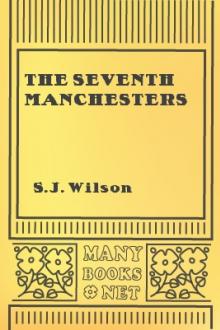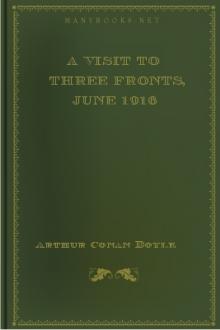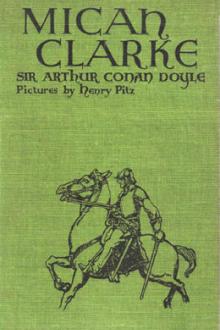The Seventh Manchesters by S. J. Wilson (top ten ebook reader .txt) 📕

- Author: S. J. Wilson
- Performer: -
Book online «The Seventh Manchesters by S. J. Wilson (top ten ebook reader .txt) 📕». Author S. J. Wilson
March and as it was undergoing re-organisation, all the second line
units, or what remained of them, were sent to the 42nd division. Capt.
Nelson also returned after a long absence since his wound in May, 1915,
and was given command of “A” company, Capt. Allen, M.C., having been
detailed to take charge of a divisional L.G. school.
CHAPTER IX.
Hammering the Hun.
SERRE RIDGE AND WARLENCOURT.
After a fortnight at Louvencourt the brigade went into the line again on
August 18th, this time on the right of the divisional front. During our
period in reserve important events had taken place south of the Somme. A
lightning stroke, chiefly delivered by the Canadian Corps who had been
suddenly and secretly rushed down from the Lens area, had altered the
whole aspect of the war, for the German Army, which not long before had
entertained such high hopes of reaching the coast and Paris, was driven
to anxiously defending his line. Weak spots in the Hun armour were being
sought out and pierced so that on the whole the enemy was having a bad
time. Anticipating trouble on the third army front he had withdrawn his
outposts to a safer line all along the Ancre and up to Puisieux, and our
men had been able to walk cautiously forward several hundred yards.
Such was the situation when the 7th took over the front line, at the
moment quite unsuspicious of the stirring events in which they were
shortly to take a share. Major Rae commanded the battalion, the C.O.
being away on Paris leave, while Capt. Barratt had resumed the duties of
Adjutant. The Company Commanders for this tour of duty were Lt. C. B.
Douglas, “A,” Capt. Grey Burn, “B,” Lt. Abbott, “C” and Capt. J. Baker,
“D.” Suddenly, without previous warning, operation orders were received
on August 20th for a big attack to commence along the whole army front
the following morning. This was rapid work indeed, and the hurried
state of preparation can be better imagined than described, especially
in view of the extraordinary nature of the barrage which called for most
accurate timing and an elaborate barrage table. The manner in which
Major Rae and Capt. Barratt swiftly dealt with all these details and
communicated their wishes to the people concerned, a task of no small
magnitude under more favourable conditions, calls for the keenest
appreciation from all who took part in that first important battle.
The division expected to cover, in the first day’s fighting, the large
mass of high ground which is flanked on its western edge by Serre and
overlooks Miraumont on the eastern side. A Prussian division was known
to be defending this part of the line. The 7th were to take part in the
initial assault in the right brigade sector, while the 125th brigade
were on the left. A thick mist enshrouded the land in the early morning
of August 21st, and doubtless many men on both sides thought of the
similar conditions which prevailed on the 21st of another month when the
Hun attacked with such terrible results. Here was the revenge and it was
to take place, curiously enough, under like circumstances. At 4.50 a.m.
the attack commenced, preceded by a short but destructive barrage over
the enemy position. For the Fleur de Lys “C” and “D” companies led off,
their objective being a part of the sunk road running across the front
from Puisieux to Beaumont Hamel. It was impossible to see more than
forty yards, and this rendered control by the officers practically out
of the question. The section commanders, however, in many cases
Lance-Corporals and even privates, rose magnificently to the occasion,
with the result that touch was maintained and the direction of advance
preserved. Short, sharp struggles took place at various points, but the
Boche were overpowered, and eventually a good line was established on
the objective. “C” company lost 2nd-Lt. Harland, M.C., and Lt.
Lofthouse, both wounded, while “D” company, although keeping their
officers, had Sgt. W. Brown killed.
The next phase of the battle comprised the attack of “A” and “B”
companies who passed through the first objectives and advanced to the
top of the ridge. Lieut. H. N. Kay of “B” company was shot dead at close
range during the clearing of a dug-out in the early stages of this
fight, while later on this company suffered heavy casualties, Sgt.
Green, D.C.M., M.M., being killed and Sgts. Guttery and Gleeson wounded.
On reaching the final objective Lt. Douglas carried out work of the
greatest value in the organisation of his company. In spite of the
strongly increasing enemy shell-fire he moved about amongst his men with
such coolness and disregard for personal danger that his example
inspired the men for the strong counter attacks which later took place.
For his splendid leadership and initiative he was afterwards awarded the
Military Cross. Capt. Grey Burn and his company on the right were having
an awkward time from enemy snipers, but he organised his now small
numbers very carefully, and personally kept the enemy under close
observation. Seeing an enemy concentration in progress, evidently for a
counter-attack, he quickly gave information, and the gunners were able
to disperse the enemy with a very effective barrage.
The conduct of all ranks during the counter-attack, which was launched
early in the afternoon, was so splendid that it broke up the Hun effort.
Later in the day the enemy made another attack with a strong body of
picked storm-troops from another division brought up specially from the
reserves, but the greeting they received from our rifle, Lewis gun, and
machine-gun fire caused enormous casualties, and the attack collapsed.
Capt. Grey Burn was decorated with the M.C. for his share in this
splendid day’s work. The ground captured in the first day’s fighting,
representing an advance of 5,000 yards, was consolidated and held for
the next two days, during which time the left of the division was
executing a turning movement to encircle Miraumont from the north. The
work of the signallers, under Lt. Smith, cannot be too highly praised
for their contribution to the success of this battle, because
communications throughout the operation were excellent and twice served
to bring down a barrage in short time, so assisting the infantry to
smash the enemy attacks. The stretcher bearers nobly performed their
work under most trying conditions, what with the heavy mist followed
later by intense heat, the badly broken ground and the long distances
they had to carry the wounded under shell fire. Lce-Cpl. Twist, M.M., of
“D” company, performed prodigies of strength and valour in this way,
receiving a bar to his M.M., and Pte. Greer, M.M., of “B” company,
proved an able second to him. Lt. Stanier was badly wounded whilst with
“A” company, losing the sight of one eye.
The next movement was the crossing of the River Ancre in the early hours
of August 23rd. This was well done by “B” company, “A” company, now
under the command of Capt. Nelson, being in support with “C” company.
During the advance, and with the co-operation of the East Lancs. north
of Miraumont, large bodies of prisoners were cut off and rounded up on
the far side of the Ancre. When the ground had been made good and it was
ascertained that the Hun had definitely retired, it was thought that the
day’s work was done. This, however, proved to be wrong, as a further
advance to Warlencourt was ordered, and it was to commence as soon as
possible. The 6th moved off about dusk with the 7th in support, and
although the right flank was exposed this did not hinder the advance.
The greater part of the movement was carried out in darkness and over
strange ground, but the leadership was very skilful and the brigade came
in contact with the enemy on the outskirts of Warlencourt about 10.30
p.m. Boche M.G. nests quickly opened a terrific fire, but few casualties
were caused. A rapid deployment took place and positions quickly
occupied in case of a surprise. The enemy fire, however, increased in
intensity, and the cover afforded being of the scantiest, it was decided
to withdraw a short distance to a line of trenches and there await
daylight. Fortunately no serious losses had been incurred, and when dawn
broke it was found that the enemy had retired still further during the
night.
At this point the division was pinched out of the line by the Naval
Division on the right and the N.Z. Division on the left converging
across our front in the next day’s advance, and we were enabled to take
advantage of a short respite from the struggle. The vigour and
effectiveness of the 42nd division’s attack has been since proved by an
unexpected tribute from the enemy. The following extract from
Ludendorf’s “Memoirs of the War, 1914-1918,” Vol. II., page 692, refers
to the fighting at this time:—
“On August 21st the English attacked south of Arras between
Boisleux and the Ancre…. As the offensive developed, the enemy
succeeded on the north in pushing us back from the Ancre. At this
point a Prussian division … given a sector covered by the river,
had failed badly. This threw the whole line into confusion…. The
situation there became extremely critical about August 25th.”
The 7th marched back a short distance to Irles, and made themselves
comfortable in the German dug-outs there for a day and a half. Looking
back over those days of new experiences for the battalion one realises
the valuable work accomplished by Lt. Wilkinson and his transport
section. When out of the line he invariably carried off the honours in
the “spit and polish” transport competitions frequently held in the
division, but it was on difficult occasions such as these that he showed
up to prouder advantage. The transport lines had been brought up to
Colincamps, and the distance from there to Warlencourt was about twelve
miles. The roads were in an impossible condition so that all supplies
had to be carried on pack animals, and the fact that nothing failed
reflects the greatest credit upon the administrative arrangements of
Capt. and Q.M. Wood and the transport officer.
VILLERS-AU-FLOS.
During our few hours’ absence from the line the Naval Division had been
in some heavy fighting as we saw when we arrived on the night of August
27th in the support position near Loupart Wood. Skilfully sited machine
guns had taken terrible toll of the brave naval men, and their bodies
still lay where they had fallen, so that one of our first jobs was to
bury them. The front line ran along the western outskirts of
Ligny-Thilloy, but it was suspected that the enemy would not make a
vigorous stand here. His shelling was particularly beastly, however, and
if he did intend to retire further he was at least taking the necessary
artillery precautions. By August 30th preparations were complete for
another forward move, but early morning showed us that the Hun had gone,
so we were merely required to follow him up.
The pre-arranged plan was carried out, and after the 127th brigade had
made good the high ground east of Thilloy, in face of some opposition,
the East Lancs. came through and took up the advance on what had now
become a one brigade front. They had not gone far before they
encountered the enemy in strength holding Riencourt, and they promptly
attacked it. The 8th Manchesters bore the brunt of this attack and they
suffered very heavily, little ground being gained. A brilliant night
show by the 10th the next night, however, subdued Riencourt, and this
rendered the line sufficiently straight to be able to continue the
advance. The 127th brigade took over the front again and rapid
preparations were





Comments (0)